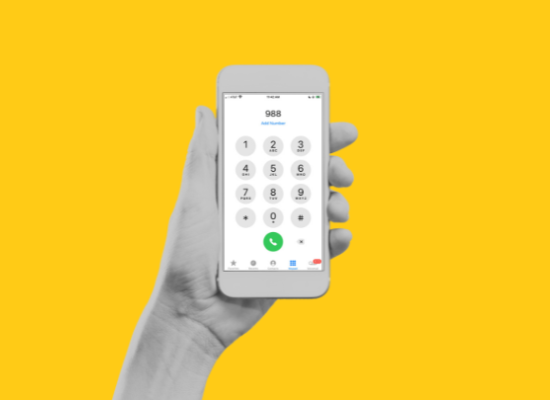
Stephanie Hepburn is a writer in New Orleans. She is the editor in chief of #CrisisTalk. You can reach her at .
It was a surprise. When Barbara Stanley, Ph.D., and Gregory K. Brown, Ph.D.—along with their research team—developed a safety plan during a treatment study on suicidal adolescents, they aimed to create a stopgap. The researchers wanted the teens to remain outpatient; they thought that would cause less disruption to the adolescents’ lives. However, they needed to keep the teens safe until they received the study’s cognitive-behavioral therapy and thought perhaps a safety plan would do the trick.
They didn’t know how right they were. In fact, the teens found the safety plan to be one of the most helpful of the study’s tools. “We weren’t thinking about it as a [clinical] tool,” said Dr. Stanley. “We thought of it as something to keep them safe until they got the ‘real’ treatment, which was our psychotherapy or medication. It turned my thinking on its head.”
The Safety Planning Intervention has now existed for over a decade. It’s typically done by a clinical provider—a licensed mental health clinician, social worker, psychologist, psychiatrist, and sometimes a nurse. Dr. Stanley believes peer support specialists should be added to the list. “With the training tailored to peers, we believe peers can administer the intervention as well or better than clinicians,” she says. “It’s relatively easy to learn and doesn’t require the diagnostic skills that doing a risk assessment does.”
Dr. Stanley has partnered with Lisa St. George and Dr. Charles T. Browning from RI International to adapt the intervention training to make it more effective for peer support specialists. “We’ve been training peers—having them do role play safety plans—and then giving them feedback,” says Dr. Stanley. The training team scores the safety plans to ensure they meet competency standards. She estimates the peer-focused training could be up and running in less than a year. (St. George is Vice President of Peer Support and Empowerment at RI International, and Dr. Browning is the company’s Chief Medical Officer.)
The brief cognitive-behavioral intervention can be administered in one session, which Dr. Stanley says makes it ideal for all mental health settings. In addition, the initial effectiveness study shows that someone can administer the intervention before a person is discharged from an emergency department. Since then, researchers have found the intervention mitigates suicide risk in outpatient and inpatient facilities—“Roughly half of inpatient psychiatric hospitalizations are suicide-related,” she says—and jail.
The risk of suicide is high in the first year following an emergency department or inpatient hospitalization. “Having a safety plan in place is critical for helping to keep someone safe,” says Dr. Stanley. A study published in JAMA in 2019 highlighted that suicide mortality among people who presented at emergency departments experiencing deliberate self-harm or suicidal ideation were 57 times higher (self-harm, with or without suicidal ideation) and 31 times higher (suicidal ideation but not deliberate self-harm) to die by suicide within the year.
However, people don’t just experience a high risk of suicide mortality when discharged from psychiatric hospitalization but also all-cause mortality. A study by the U.S. Department of Veterans Affairs found patients at high risk for premature mortality, particularly in the first one to three months after discharge, including suicide and other external-cause deaths. In 2020, Dr. Ira R. Katz told us that over 19% of suicides post-discharge happened in the first 30 days and 39.9% within the initial 90 days. However, rates of other external-cause deaths were high throughout the year.
“We…found that the rates of other external deaths in the year after discharge were greater than the rate of suicide among younger veterans discharged from our facilities,” said Dr. Katz. “Deaths from accidental overdoses and injuries were more frequent than deaths from suicide.” He also clarified that it’s challenging to determine whether a death is intentional or accidental. “…We have to recognize that what is a suicide, and what is not, is fuzzy. Was the person distracted when stepping in front of a car, or was it intentional?”
While studies have illustrated the Safety Planning Intervention mitigates suicide risk by 30% in the first year post-discharge and 45% in the first six months when done with follow-up compared to usual care—it’s unclear whether researchers have looked at whether it could help in all-cause mortality—that doesn’t mean it’s always done in those settings. One challenge, notes Dr. Stanley, is emergency department hospital staff often say they don’t have the time or training to do safety planning with patients. The question then becomes who can do it and do it effectively. “Peer support specialists are a natural fit—they have lived experience and know what it’s like to get through suicidal crises, allowing them to develop a very meaningful safety plan with the person.”
Peer support specialists can often reach people in crisis, and in crisis care, in a way that clinicians can’t. “They lean into their empathy and acceptance of others to connect with someone in a suicidal crisis,” says Dr. Stanley.
Studies illustrate peer support programs result in fewer crisis events and hospitalizations—people who take part also experience improved social functioning, quality of life, and recovery. For example, RI International has reported that hospital-based peer support specialists reduced hospital readmission by 56% in two Phoenix hospitals, Desert Vista Behavioral Health Center and the Maricopa Medical Center Behavioral Health Annex. In addition, a pilot study in Alberta, Canada, found that peer and text message support reduced psychiatric readmissions and emergency department visits by 10-25%.
While some peer support specialists review and update safety plans, they haven’t yet been trained to administer them. However, a pilot published in Psychiatric Services in May found that peer-delivered safety planning in an emergency department was more complete and of higher quality than those delivered by a mental health provider. Participants with peer-delivered safety planning had fewer repeat emergency department visits in the subsequent three months.
As with person-centered treatment, training shouldn’t be one size fits all. Dr. Stanley points out that the role and approach of peer support specialists differ from clinicians—the team is adapting the intervention training to allow peers to use their strengths. “Safety planning is always collaborative, but with a peer, the emphasis is that the suicidal person is in the driver’s seat.” She also notes that training needs to allow peers to be peers and share their own lived experiences and “what works and doesn’t work for them.”
Amending the Safety Planning Intervention training has also been collaborative, with Dr. Stanley, St. George, and Dr. Browning listening and incorporating feedback from peer support specialist trainees. “They’ve shared with us that the training needs to be more experiential and less instructional,” says Dr. Stanley. “The didactic is important, but it’s the practice of doing the plan they’ve found most useful.” That includes demonstrations and role play. “It’s less describing and more doing.”
Adding peer support specialists to the list of those who can administer a safety plan will probably increase the use of the intervention in all settings, helping to fill a critical gap in suicide prevention—the time between discharge and treatment. Dr. Stanley says increasing the intervention’s use, which only takes about 45 minutes, has the potential to save lives. However, the idea isn’t to thrust peers into a clinical role but to give people access to an intervention with a person who is “fully present and who will connect with them.” “Peers are very focused,” she says, “on being patient-centered.”









